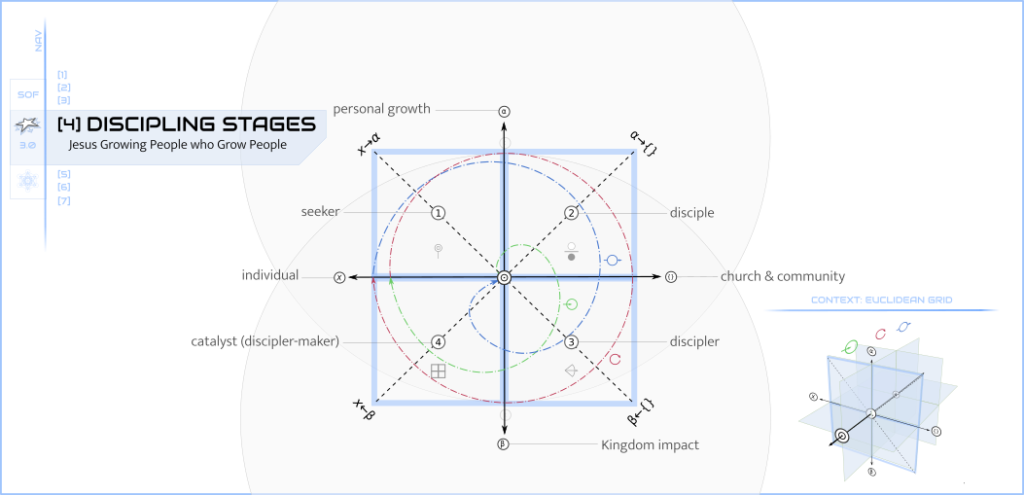Disciplemaking Dimension of Multiplication Course: Module 1 Notes
Lately I’ve been taking online courses as part of Exponential’s Multipliers Learning Communities which I’m completing as part of my work with Lancaster Mennonite Conference’s NYC District. You can see the first post in the series here which explains more about the process and framework of this experience. I’m on to the second course required before our field trip to Cross and Crown Church in Seattle in a few days: Disciplemaking Dimension of Multiplication: Module 1 “Level 5 Disciplemaking”.
Module 1 introduces a framework for evaluating discipleship behaviors which is very similar to the 5-level framework Exponential uses for church growth. In fact, its the same framework. Based on the reading, I found myself wondering if the discipleship movement of the 1960s and 70s produced the framework that then Exponential adapted to evaluate churches. Either way, in this module they describe 5 “disciple profiles” typified by specific behaviors:

- A subtracting disciple: a skeptical and consuming disciple to detracts for the efforts of others to be discipled and disciple others.
- A plateau disciple: a consuming disciple who neither really detracts not helps with discipleship or disciple making.
- A adding disciple: a disciple who contributes to efforts — often programmatically — to grow and help other grow.
- A reproducing disciple: a disciple who is personally and relationally active in producing other disciples.
- A multiplying disciple: a disciple who makes disciples who make disciples.
You can get Exponential’s free Becoming a Disciple Maker ebook if you’d like more detail on the profiles.
Overall, I absolutely agree with the desire to produce “Level 5, Multiplying Disciple Makers” since they are the drivers of Gospel Movements or the spontaneous/organic expansion of the Gospel/church into the world. I would like to make a distinction, however, on whether the 5 levels they articulate should be considered normative for Jesus followers. In my first post on this course work, I argue that the 5-Level Framework — especially with the “Level 3 Growth Magnet” — should not be considered a normative evolutionary path for gospel community. Instead, the 5-Levels describe, in my evaluation, a Western Church given over to idols of consumerism and consumption and desperately in need of repentance.
Therefore the legitimate path of discipleship should not be modeled on the 5-Level Framework. It may be useful in describing the position of church members in located in churches in the 5-Level continuum, but it should not be the path envisioned for the those who are awaiting their first Gospel encounter, the not-yet-churched, and the unchurched. If I were to design a mission work to catalyze a Gospel Movement outside to institutions, I would not design this pathway for people to follow.
Especially problematic is calling Level 1 and 2 church members “disciples”. The crowds who listened to Jesus’ teaching or who witnessed his miracles were not disciples for simply being there. The disciples were the ones who followed him when he left to preach to the next village. Discipleship is defined by following. If there isn’t movement along with Jesus, there is no discipleship. There may be church membership. There may be acknowledgement of religious ideas. There may be consumption of religious services. But that would also be true of the hostile crowds and Pharisees. What is necessary is clear: “Whoever does not bear his own cross and come after me cannot be my disciple.” [Luke 14:27 ESV] In my opinion, the single greatest institutional drag on a Gospel movement is our low-bar definition of a disciple that tolerates and waits endlessly and offers the majority of resources to those willing to do nothing to actually follow Jesus in anything other than their imaginations.
Again, the Level 3 definition of a disciple should not be Gospel-normative. It may describe that pathway of programmatic churches in the process of repentance and dismantling. But the idea of a disciple following Jesus by primarily by supporting programming is dangerous for both a movement and a disciple. The story of Andrew and The Woman at the Well and the Sending of The 12 and The Seventy-Two, shows that the normative thing is for a disciple who has encountered Jesus to immediately begin producing the fruit missionally and relationally — first in small ways and then in deeper and broader ways.
A better developmental pathway would look like this:

Faith first emerges in the Seeker who is active in finding God and encountering Jesus. They are still, however, “counting the cost” and comprehending whom/that to which they are committing their lives. In this stage Jesus comes “into and out of” their life like he periodically passed through villages and cities on his preaching circuit. One day, they follow him as he moves away from where they used to be and they become a Disciple on journey with him. They learn the Way of Jesus: “what I hear the Father saying, I say,” and “what I see the Father doing, I do.” This naturally plants Gospel seeds in the life of others which will sprout into faith. As the disciple grows in intimacy with Jesus through this work, their identity will shift from a learner to a co-worker and they will come a Discipler who supports others on their journey of discipleship. They encounter and move in-and-out of the lives of seekers, and they walk side-by-side with disciples as the teach and demonstrate the Way of Jesus. Watching this process over and over produces deeper still intimacy with Father, Son, and Spirit so that they become a Catalyst who is a discipler-maker: they call and support disciples who make disciples who make disciples. This multiplies the community of people moving in-and-out of the lives of Seekers and journeying together as they follow Jesus so much so that movement grows spontaneously from their work in every direction. The disciple, discipler, and catalyst are all good soil, yielding seed 30-, 60-, and 100-fold.
While I totally agree with Exponential’s point that we must be all about the creation of Level 4 ( = discipler) and Level 5 disciples ( = catalyst), I think it is also important to free our imaginations to dream of a day when the generations who follow us won’t have to fight against “The Maw” of super-consumption or the “Level 3 Magnet” — at least in the church — to be able to follow Jesus and join him in his work in the world.
As part of this module, I completed the online Disciple Maker Assessment. My “pattern” is 4-4-5: Level 4 in the past 12 months, Level 4 in the past years, and Level 5 towards the future, mostly because the reproduction has been spotty in those I have been discipling. I think there are two reasons for this. First, my life situation for the past seven years has prevented much in the way of catalytic Level 5 work. While I have been reproducing, I’ve been doing it while managing work challenges and building our family from 4 to 8 members. Such was the season God ordained for my good and refining. But also, recently I’ve come to understand the last season of my life was meant to acquaint me intimately with the cross of Jesus. One meaning of the cross that stems from this experience is that unless Jesus died, the movement could never be truly ours — his disciples — and therefore we would not be truly able to know him and join him intimately in his work. Through this lens, I realized how much I was both over-doing and holding back with those I discipled because I wanted to protect them from the costs of mission or didn’t think they had the competence or toughness for it. This shift has been recent and is still sinking in, but it has produced immediate fruit in my discipling relationships and has exactly co-coincided with my being called as a region Catalyst in NY-PA-NJ, and a Missional Catalyst for the LMC NYC District.
Follow along as I continue my journey through this course here.




Responses